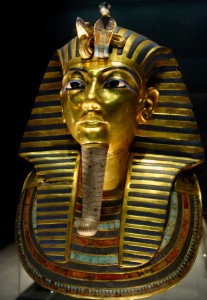Tutankhamun Mask

CC-BY-SA-3.0.
The well-known boy Pharaoh Tutankhamun (also known as Tutankhamen or colloquially as King Tut) was a short-lived Pharaoh from the 18th Dynasty (during the Egyptian New Kingdom). He died when still young and is important because his tomb (Tomb KV62) in the Valley of the Kings was found almost intact by Howard Carter in 1922. During his life, he changed his name from Tutankhaten to Tutankhamun as a result of changes in the religion officially practised in Egypt.
The body of Tutankhamun was found within his tomb. Inside his sarcophagus were three nested coffins. The innermost one of these was made of solid gold, while the outer two were made of gilded wood. The death mask, and the mummy trappings with which it was associated, attempted to transform the mummy of the Pharaoh into a replica of an anthropoid coffin, complete with hands and sceptres (Ikram & Dodson 1998: 171).
Reading
Ikram, S. & Dodson, A. 1998. The Mummy in Ancient Egypt. London: Thames & Hudson.
Reeves, C. N. 2007. The Complete Tutankhamun. London: Thames & Hudson.

Leave a Reply